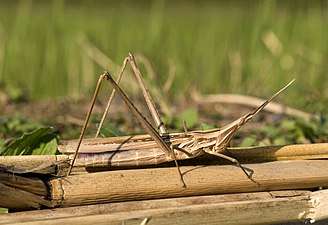Acrida cinerea
Acrida cinerea, sometimes called the Oriental longheaded grasshopper/locust[1] or the Chinese grasshopper[2] (though this name is also applied to Oxya chinensis), is a member of the Acrididae family. Like other members of the genus Acrida, Acrida cinerea lacks stridulatory organs on its legs and so they do not make noise whilst moving.[2]
| Acrida cinerea | |
|---|---|
 | |
| Scientific classification | |
| Kingdom: | Animalia |
| Phylum: | Arthropoda |
| Class: | Insecta |
| Order: | Orthoptera |
| Suborder: | Caelifera |
| Family: | Acrididae |
| Subfamily: | Acridinae |
| Tribe: | Acridini |
| Genus: | Acrida |
| Species: | A. cinerea |
| Binomial name | |
| Acrida cinerea (Thunberg, 1815) | |
Historically it has been used as a human food source,[2] and it has been investigated for its nutritional value for the poultry industry (e.g., Wang et al. 2007[3]).
Description
Acrida cinerea males are typically 40–50 mm (1.6–2.0 in) in length while females are 70–80 mm (2.8–3.1 in).[1] They are either green or brown in color with colorless wings.[2] A. cinerea has long legs which allow it to jump long distances.
gollark: Surely you can just pull a particular tag of the container.
gollark: I can come up with a thing to transmit ubqmachine™ details to osmarks.net or whatever which people can embed in their code.
gollark: It's an x86-64 system using debian or something.
gollark: > `import hashlib`Hashlib is still important!> `for entry, ubq323 in {**globals(), **__builtins__, **sys.__dict__, **locals(), CONSTANT: Entry()}.items():`Iterate over a bunch of things. I think only the builtins and globals are actually used.The stuff under here using `blake2s` stuff is actually written to be ridiculously unportable, to hinder analysis. This caused issues when trying to run it, so I had to hackily patch in the `/local` thing a few minutes before the deadline.> `for PyObject in gc.get_objects():`When I found out that you could iterate over all objects ever, this had to be incorporated somehow. This actually just looks for some random `os` function, and when it finds it loads the obfuscated code.> `F, G, H, I = typing(lookup[7]), typing(lookup[8]), __import__("functools"), lambda h, i, *a: F(G(h, i))`This is just a convoluted way to define `enumerate(range))` in one nice function.> `print(len(lookup), lookup[3], typing(lookup[3])) #`This is what actually loads the obfuscated stuff. I think.> `class int(typing(lookup[0])):`Here we subclass `complex`. `complex` is used for 2D coordinates within the thing, so I added some helper methods, such as `__iter__`, allowing unpacking of complex numbers into real and imaginary parts, `abs`, which generates a complex number a+ai, and `ℝ`, which provvides the floored real parts of two things.> `class Mаtrix:`This is where the magic happens. It actually uses unicode homoglyphs again, for purposes.> `self = typing("dab7d4733079c8be454e64192ce9d20a91571da25fc443249fc0be859b227e5d")`> `rows = gc`I forgot what exactly the `typing` call is looking up, but these aren't used for anything but making the fake type annotations work.> `def __init__(rows: self, self: rows):`This slightly nonidiomatic function simply initializes the matrix's internals from the 2D array used for inputs.> `if 1 > (typing(lookup[1]) in dir(self)):`A convoluted way to get whether something has `__iter__` or not.
gollark: If you guess randomly the chance of getting none right is 35%ish.
References
- Rowan Hooper. "Oriental long-headed locust". The Japan Times. Retrieved 2018-05-20.
- Dana Campbell. "Chinese Grasshopper - Acrida cinerea - Details - Encyclopedia of Life". Encyclopedia of Life. Retrieved 2018-05-20.
- Wang, Dun; Zhai, SW; Zhang, Chuan-Xi; Zhang, Qiang; Chen, Hui (2007). "Nutritional value of Chinese grasshopper Acrida cinera (Thumberg) for broilers". Animal Feed Science and Technology. 135: 66–74. doi:10.1016/j.anifeedsci.2006.05.013. Retrieved 2018-05-20.
External links

This article is issued from Wikipedia. The text is licensed under Creative Commons - Attribution - Sharealike. Additional terms may apply for the media files.